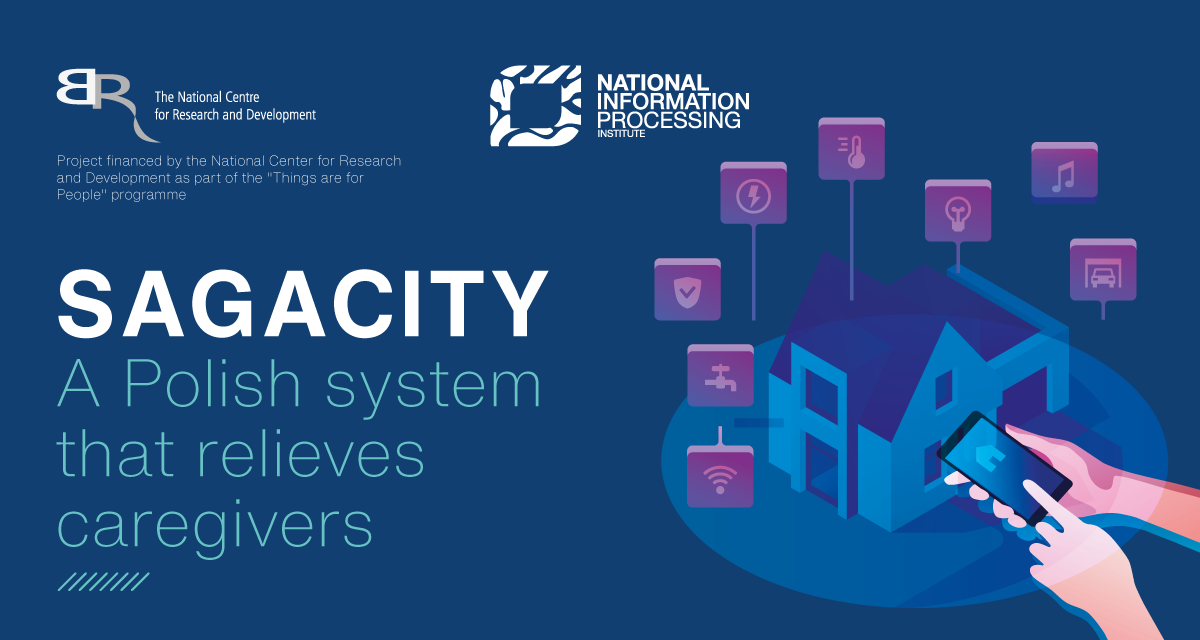The National Information Processing Institute (OPI PIB) and its partners, Kobo Association and Big Idea Technology sp. z o.o., have received a subsidy from the National Centre for Research and Development (NCBR) that was granted as part of the Rzeczy są dla ludzi (‘Things in the Service of People’) competition. The consortium’s goal is to develop and implement Sagacity, a system designed to improve the lives of people with special needs. The ground-breaking solution, which is based on wireless bioelectric signal amplifiers, has made it feasible to commercialise a comprehensive tool that controls smart home systems. Sagacity relies on solutions that are based on 433 MHz technologies, which entail few to no home alterations; only standard electrical wiring and a Wi-Fi network are required.
Sagacity has been developed by experts at OPI PIB in collaboration with the institute’s partners. The system will enable control of everyday devices without having to rely on traditional motor or vocal skills. It will make individuals with special needs less dependent on their caregivers, increasing their comfort and improving their mental health. Those who do not suffer from health problems will also welcome Sagacity as a new method of controlling smart home systems that is more convenient than others.
‘Sagacity is not the first project developed by the National Information Processing Institute that has attracted the attention of NCBR. This year, we have also received a subsidy to implement artificial intelligence in prostate cancer diagnosis. New technologies are being used to better preserve human lives and health. I am glad that the activities of OPI PIB align with this trend. Although Sagacity will make the lives of healthy people easier, it will prove the most useful to people with movement and speech disorders. Many everyday tasks that presently require the help of a caregiver can now be done independently,‘ says Dr Jarosław Protasiewicz, Head of the National Information Processing Institute.
The use of eye movement and muscle tone
The Sagacity system carries enormous potential. The technology will aid the elderly by removing technical barriers in their homes. It will enable them to control lighting and electrical sockets with electrooculogram (EOG) amplifiers, using eyeball movement and electromyogram (EMG) amplifiers. Thanks to the system’s easily adaptable modular structure, it will soon be possible to apply the same technology in other areas, including in the positioning of medical beds, the monitoring of anti-decubitus mattress pumps, and the provision of call buttons to summon caregivers.
‘The development of EOG and EMG amplifiers can make the lives of disabled people easier by helping them with their everyday tasks. The first stage of the project is going to focus on developing a system that controls lighting and electrical sockets; in the future, we would like to add other functionalities. What healthy people find obvious and easily accessible can soon also become so for individuals with special needs. Sagacity is designed to improve integration between our bodies and the world around us, which is already full of new, interconnected technologies (such as IoT). We intend to design and implement a product that enables people with special needs to control everyday devices as easily as others do,’ says Cezary Biele, Head of the Laboratory of Interactive Technologies at OPI PIB
A unique ‘bioelectric PIN’
All current smart assistants are touch- or voice-controlled: to activate and operate many of them, users must articulate commands loudly and clearly—sometimes in a foreign language. These constraints are difficult to overcome for users who have multiple and complex needs. Sagacity will be the first system on the market that uses wireless EOG/EMG amplifiers to control devices that are connected to smart home networks. Its designers also intend to create a software platform that identifies and interprets individual bioelectric patterns. The solution will be used to identify and authenticate users based on EOG/ EMG data; this is known as the ‘bioelectric PIN’ method, and entails registering specific bioelectric patterns and identifying users with them. Sagacity is a novelty both on the Polish and international markets. The project has been subsidised by NCBR as part of the Rzeczy są dla ludzi (‘Things in the Service of People’) competition. The innovative tool is scheduled to be available by May 2025.
